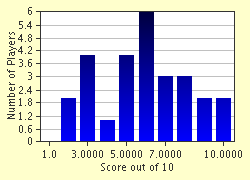Quiz Answer Key and Fun Facts
1. Despite citing Western writers as some of his major influences, from which Asian country does Murakami hail?
2. Legend has it that Murakami was struck with the inspiration to write his first novel 'Hear the Wind Sing' while watching Dave Hilton hit a double for the Yakult Swallows. What sport was he watching?
3. The big break for Murakami came in 1987 with the publishing of a book that shares its name with a Beatles song. Which multi-million-copy selling book was this?
4. Despite Murakami being a great lover of cats, they don't always have it easy in his writing. In the 2002 novel 'Kafka on the Shore', which cane-toting whisky mascot turns out to be a notorious cat murderer?
5. While he mainly writes fiction, Murakami has also tried his hand at writing about himself. Which of his hobbies completes the title of his book 'What I Talk About When I Talk About _____'?
6. One of Murakami's more adventurous novels follows the closely intertwining lives of Aomame and Tengo, who haven't met since a brief primary school encounter. What is the title of this Orwell-inspired novel, coming from the alternate reality in which the main characters find themselves?
7. Murakami frequently uses themes of loneliness in his work, causing many critics to compare him to which German-language author, whose namesake literary prize he won in 2006?
8. Translation is yet another feather in Murakami's literary cap. Having owned a jazz club earlier in his life, it comes as no surprise that he has translated which of the following classics into his native language?
9. Many of Murakami's novels discuss classical music, and one book even has section titles with a classical music theme. Which novel is this, in which the three sections are named for a Rossini opera, a Schumann piano piece and a character from Mozart's 'The Magic Flute'?
10. In 2015, publisher Shinchosha set up the website 'Murakami-san no tokoro' or 'Mr. Murakami's Place', allowing readers to take part in what activity?
Source: Author
pagea
This quiz was reviewed by FunTrivia editor
looney_tunes before going online.
Any errors found in FunTrivia content are routinely corrected through our feedback system.

